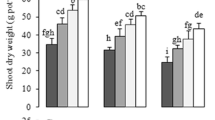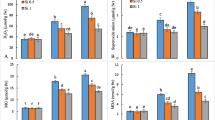Abstract
Hydroponic experiments were conducted to investigate the role of exogenous silicon (Si) addition in increasing hexavalent chromium (Cr VI) tolerance in rice seedlings. Rice seedlings were grown under 100 μM Cr(VI) stress without or with 10 μM Si. Chromium treatment decreased growth, photosynthetic pigments and protein, which was accompanied by a significant increase in Cr accumulation and lipid peroxidation (as malondialdehyde; MDA). However, Si addition alleviated Cr toxicity and promoted growth of rice by decreasing Cr accumulation, root-to-shoot Cr transport and MDA level. Contents of macro (Mg, Ca and K) as well as micronutrients (Zn and Fe) were decreased by Cr except Mn while Si addition prevented decrease in these nutrients induced by Cr. Antioxidant capacity and total phenolic contents were decreased by Cr while these indices improved by Si addition. Treatment of Cr decreased the length of leaf epidermal cells and stomatal frequency, and adversely affected chloroplasts containing mesophyll cells and integrity of xylem and phloem, and Si addition minimized these abnormalities. However, frequency of root hairs was increased by Cr treatment. Results showed that exogenous Si addition enhanced Cr(VI) tolerance in rice seedlings by decreasing Cr accumulation, root-to-shoot Cr transport and MDA level, and by increasing content of some mineral elements (K, Fe and Zn) and antioxidant capacity compared to the Cr treatment alone.



Similar content being viewed by others
References
Arditti J, Dunn A (1969) Environmental plant physiology—experiments in cellular and plant physiology. Rinehart and Winston Inc, Holt
Arnon DI (1949) Copper enzymes in isolated chloroplasts. Polyphenoloxidase in Beta vulgaris. Plant Physiol 24:1–15
Brand Willimas W, Cuvelier ME, Berset C (1995) Use of a free radical method to evaluate antioxidant activity. LWT-Food Sci Tech 28:25–30
Chandra P, Kulshreshtha K (2004) Chromium accumulation and toxicity in vascular plants. Bot Rev 70:313–327
Chérif M, Benhamou N, Menzies JG, Bélanger RR (1992) Silicon induced resistance in cucumber plants against Pythium ultimum. Physiol Mol Plant Pathol 41:411–425
Epstein E (1999) Silicon. Annu Rev Plant Physiol Plant Mol Biol 50:641–664
Gangwar S, Singh VP (2011) Indole acetic acid differently changes growth and nitrogen metabolism in Pisum sativum L. seedlings under chromium (VI) phytotoxicity: Implication of oxidative stress. Sci Hortic 129:321–328
Gikas P, Romanos P (2006) Effects of tri-valent [Cr(III)] and hexa-valent chromium [Cr(VI)] on the growth of activated sludge. J Haz Mat 133:212–217
Heath RL, Packer L (1968) Photoperoxidation in isolated chloroplasts I. Kinetics and stoichiometry of fatty acid peroxidation. Arch Biochem Biophys 125:189–198
Hossain MT, Mori R, Wakabayashi KSK, Fujii SKS, Yamamoto R, Hoson T (2002) Growth promotion and an increase in cell wall extensibility by silicon in rice and some other Poaceae seedlings. J Plant Res 115:23–27
Ikan R (1969) Natural products. A laboratory guide. Academic Press, New York
Kennedy BM, Schelstraete M (1975) A note on silicon in rice endosperm. Am Assoc Cere Chem 52:854–856
Kotas J, Stasicka Z (2000) Chromium occurrence in the environment and methods of its speciation. Environ Poll 107:263–283
Liang YC, Wong JWC, Wei L (2005) Silicon-mediated enhancement of cadmium tolerance in maize (Zea mays L.) grown in cadmium contaminated soil. Chemosphere 58:475–483
Liu X, Ardo S, Bunning M, Parry J, Zhou K, Stushnoff C, Stoniker F, Yu L, Kendall P (2007) Total phenolic content and DPPH· radical scavenging activity of lettuce (Lactuca sativa L.) grown in Colorado. LWT Food Sci Tech 40:552–557
Lowry OH, Rosebrough NJ, Farr AL, Randall RJ (1951) Protein measurement with the folin phenol reagent. J Biol Chem 193:265–275
Lux A, Luxová M, Hattori T, Inanaga S, Sugimoto Y (2002) Silicification in sorghum (Sorghum bicolor) cultivars with different drought tolerance. Physiol Plant 115:87–92
Ma JF, Tamai K, Yamaji N, Mitani N, Konishi S, Katsuhara M, Ishiguro M, Murata Y, Yano M (2006) A silicon transporter in rice. Nature 440:688–691
Marschner H (1999) Mineral Nutrition in Higher Plants. Academic Press, Harcourt B, Company Publishers, London
Moreira OC, Rios PF, Barrabin H (2005) Inhibition of plasma membrane Ca2+-ATPase by Cr ATP. LaATP but not CrATP stabilizes the Ca2+-occluded state. BBA-Bioenergetics 1708:411–419
Morgan PW, Taylor DM, Joham HE (1976) Manipulations of IAA oxidase activity and auxin deficiency symptoms in intact cotton plants with manganese nutrition. Physiol Plant 37:149–156
Neumann D, zur Nieden U (2001) Silicon and heavy metal tolerance of higher plants. Phytochemistry 56:685–692
Nwugo CC, Huerta AJ (2008) Effects of silicon nutrition on cadmium uptake, growth and photosynthesis of rice plants exposed to low-level cadmium. Plant Soil 311:73–86
Peng Q, Zhou Q (2010) Effects of enhanced UV-B radiation on the distribution of mineral elements in soybean (Glycine max) seedlings. Chemosphere 78:859–863
Savant NK, Korndörfer GH, Datnoff LE, Snyder GH (1999) Silicon nutrition and sugarcane production: a review. J Plant Nutr 22:1853–1903
Schiavon M, Pilon-Smits EAH, Wirtz M, Hell R, Malagoli M (2008) Interaction between chromium and sulfur metabolism in Brassica juncea. J Environ Qual 37:1536–1545
Shanker AK, Djanaguiraman M, Sudhagar R, Chandrashekar CN, Pathmanabhan G (2004) Differential antioxidative response of ascorbate glutathione pathway enzymes and metabolites to chromium speciation stress in green gram (Vigna radiata (L.) R. Wilczek. Cv CO 4) roots. Plant Sci 166:1035–1043
Sinha S, Singh S, Mallick S, Sinam G (2009) Role of antioxidants in Cr tolerance of three crop plants: metal accumulation in seeds. Ecotoxicol Environ Saf 72:1111–1121
Swain T, Hillis WE (1959) The phenolic constituents of Prunus domestica.l.—the quantitative analysis of phenolic constituents. J Sci Food Agric 10:63–68
Toor RK, Savage GP (2006) Changes in major antioxidant components of tomatoes during post-harvest storage. Food Chem 99:724–727
Vernay P, Gauthier-Moussard C, Hitmi A (2007) Interaction of bioaccumulation of heavy metal chromium with water relation, mineral nutrition and photosynthesis in developed leaves of Lolium perenne L. Chemosphere 68:1563–1575
Wang L, Wang W, Chen Q, Cao W, Li M, Zhang F (2000) Silicon-induced cadmium tolerance of rice seedlings. J Plant Nutr 23:1397–1406
Wang YX, Stass A, Horst WJ (2004) Apoplastic binding of aluminum is involved in silicon-induced amelioration of aluminum. Plant Physiol 136:3762–3770
Yokel RA, Lasley SM, Dorman DC (2006) The speciation of metals in mammals influences their toxicokinetics and toxicodynamics and therefore human health risk assessment. J Toxicol Environ Health Part B Crit Rev 9:63–85
Zhang C, Wang L, Nie Q, Zhang W, Zhang F (2008) Long-term effects of exogenous silicon on cadmium translocation and toxicity in rice (Oryza sativa L.). Environ Exp Bot 62:300–307
Acknowledgments
Authors are thankful to The Head, Department of Botany, University of Allahabad, Allahabad for providing laboratory facilities, and Dr. Devinder Kour, Centre of Food Technology, University of Allahabad, Allahabad for help in measuring parameters related to oxidative stress and antioxidants. Authors are also grateful to the University Grant Commission, New Delhi for financial support.
Author information
Authors and Affiliations
Corresponding author
Additional information
Communicated by J.-H. Liu.
Rights and permissions
About this article
Cite this article
Tripathi, D.K., Singh, V.P., Kumar, D. et al. Impact of exogenous silicon addition on chromium uptake, growth, mineral elements, oxidative stress, antioxidant capacity, and leaf and root structures in rice seedlings exposed to hexavalent chromium. Acta Physiol Plant 34, 279–289 (2012). https://doi.org/10.1007/s11738-011-0826-5
Received:
Revised:
Accepted:
Published:
Issue Date:
DOI: https://doi.org/10.1007/s11738-011-0826-5




